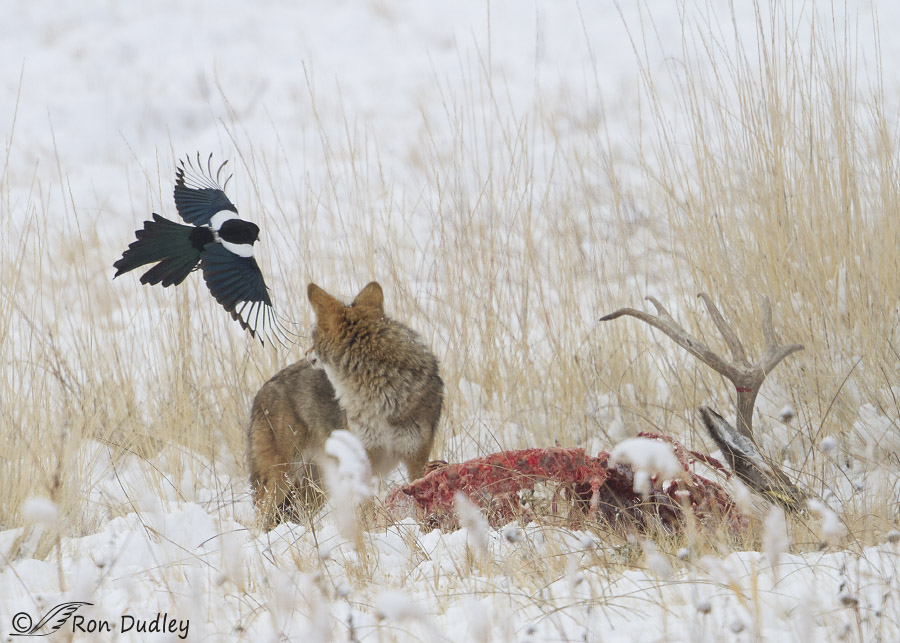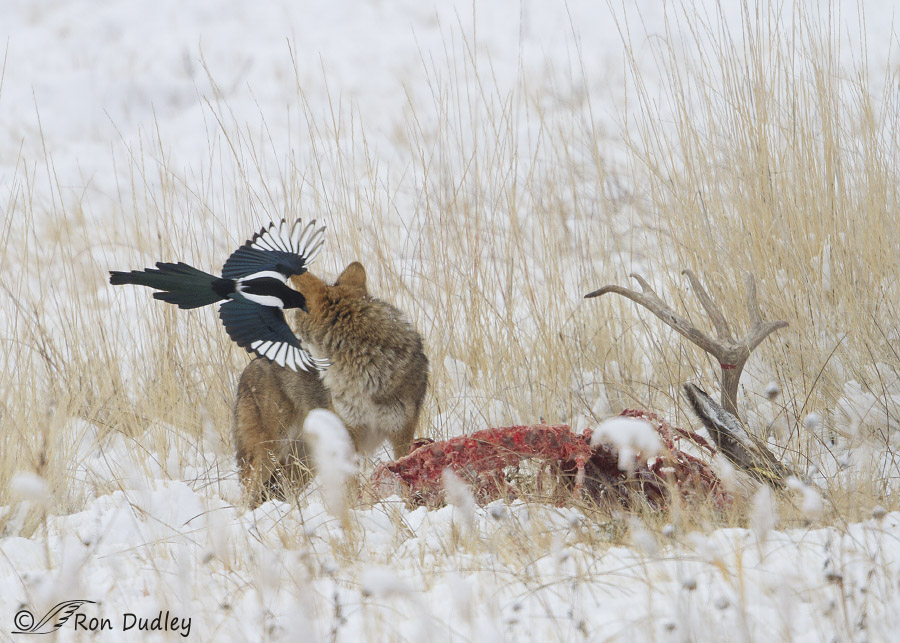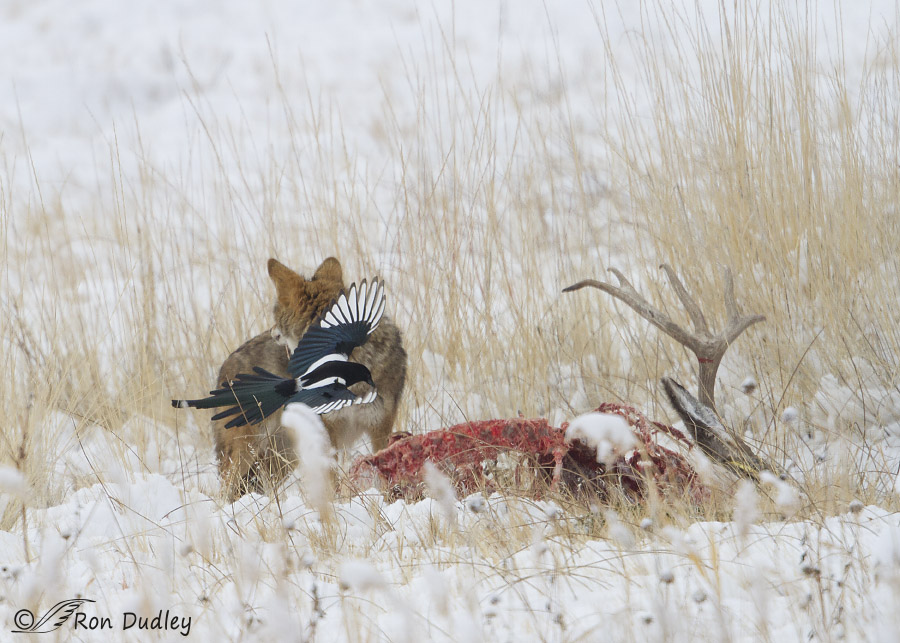What you see isn’t always what you get in nature photography. The following three images, taken sequentially in a burst, illustrate my point. This image series was taken on Antelope Island six days ago.

1/2500, f/6.3, ISO 800, Canon 7D Mark II, Canon EF500mm f/4L IS II USM +1.4 tc, not baited, set up or called in
Before we go further please look at this photo for a moment and then compose a short sentence in your mind that accurately describes the basics of what is happening in the image. I know it’s rather an unusual request but please humor me and do it.
Thanks for your indulgence. Perhaps your sentence is somewhat similar to this one – ” A coyote at a deer carcass in the snow with the coyote looking back at a magpie in flight”. The first time I looked at this image that’s precisely what I thought I saw. If so you’d be wrong, as I was.

1/2500, f/6.3, ISO 800, Canon 7D Mark II, Canon EF500mm f/4L IS II USM +1.4 tc, not baited, set up or called in
The next image in the burst shows that the magpie is really in front of the coyote instead of behind it and that the coyote is looking at something other than the bird (it was fearful of the potential approach of another pair of coyotes that had been feeding on the carcass earlier).

1/2500, f/6.3, ISO 800, Canon 7D Mark II, Canon EF500mm f/4L IS II USM +1.4 tc, not baited, set up or called in
And that reality is reinforced in this third and final image in the sequence.
Our (my) perspective in the first shot was deceived in part by the direction the coyote was looking – seemingly at the bird in flight. My brain made a snap decision that that was what was going on and ran with it. Without the last two images for clarification reality would never be known.
The confusion is also partly due to one of the effects of telephoto lenses which can make the relative distance of objects in an image difficult to judge. Since I tend to be a blog “storyteller” this is something I have to be very careful about when composing text that describes a behavior or event in my photos.
It’s embarrassing to be wrong in such a public forum…
Ron


Great and AMAZING shots, Ron! Hope your 7d MkII is working fine- mine is giving me a lens error (01) that I didn’t have with the original 7d or 40d,60d or 70d so it has to be the body. You mention using the 500mm, a great lens but from seeing your work I know it’s a HECK of a lot more than great equipment! The illusion here is more than what I’ve see but I’ve had a couple were I wondered…what just happened here???
This is akin to those optical illusions containing two different images. I originally saw the coyote looking back at the magpie, but now that I know the truth, it’s obvious the magpie is in front of the coyote. I cannot even force myself to see what I originally saw.
Very interesting and great shots. Did you find out what the coyote was looking at?
Charlotte
Charlotte, I don’t believe the coyote was looking “at” anything. I think he was simply on the lookout for those two coyotes who had been on the carcass earlier. This one was very nervous and jumpy, constantly looking around. If the other two had come back there would likely have been a nasty incident unless this one vamoosed quickly.
Great photos, Looks like a collar also.
Thanks, Earl.
My sentence had something to do with the Magpie dive-bombing the coyote to chase it away from the carcass. Very interesting series of photos. Thanks for posting it.
Thank you, Susan.
Some minds, and some eyes (mine) are more easily fooled than others. And yes, I would have been fooled (again).
Lovely sequence. And it looks like plenty of food for all.
” it looks like plenty of food for all”
There was for a short while, EC. It didn’t take them long to pick the carcass clean.
It’s fun to revisit this and read others’ comments. Indeed, this series beautifully illustrates of how magpies opportunistically plunge at the precise moment when their competitors are distracted. Another cue is how the sharp focus of the magpie matches the sharp focus of the foreground, rather than the softer lines of the grasses beyond the coyote. I picked that out at the onset, thanks to your advance warning. But the urge to create the first story line that comes to mind is a compelling one!
“the urge to create the first story line that comes to mind is a compelling one!”
Once our minds have interpreted an image one way it takes compelling evidence to alter that perception, doesn’t it, Alison.
I thought the Magpie was divebombing the coyote as the coyote watched. Totally fooled. Or that magpie is a time-jumper!
Or that magpie is a time-jumper!
“The eye of the beholder” isn’t it, Arwen?
My first thought was: Tough winter with a concerned Coyote over a deer carcass, a hungry Black-billed Magpie looking for a quick steal.
Sorry Ron, I was thinking that the Coyote was concerned and looking to see if another Coyote was going to compete for his find. I felt the Magpie was in front of the Coyote. Magpies are notorious for stealing food from predators when they aren’t looking so it didn’t occur to me that the Coyote was looking at the Magpie.
Great shots!!
Interesting that you weren’t fooled, Dick. In a previous post (that you saw) I mentioned that this coyote was concerned about other coyotes coming in so maybe that’s why your mind didn’t go where mine did.
Or perhaps you’re just smarter than I am…:) Either way, thanks for reporting your honest initial interpretation!
Your absolutely correct with that assumption. My mind immediately grasped the previous post of yours, so your right on. But, I’m also aware of Magpies behavior, much like Gray Jays, who will steal food from your picnic table when your back in turned. These thieves are smart and know how to stay out of harms way.
No, I wouldn’t even consider, for a moment, that I’m smarter then you! Plus the fact, as a photographer, I am a rank amateur and have a ton to learn!
“These thieves are smart and know how to stay out of harms way”
So true, Dick. That was SO evident as I watched them (in groups) within about 2 feet of the coyote as they fed on the carcass. A couple of times the coyote snapped at the magpies but those birds knew precisely what their range of safety was.
Interesting lesson in jumpling to conclusions! How the images lined up indeed gave a deceptive spin to photo number one. Thanks for pointing out this potential to make false assumptions. Patience and scrutiny enrich our understanding and this is a great example. Thanks.
Alison, When I was reviewing my images I really did a double-take when I went from the first in this series to the second. Had to go back again and confirm that I had been fooled.